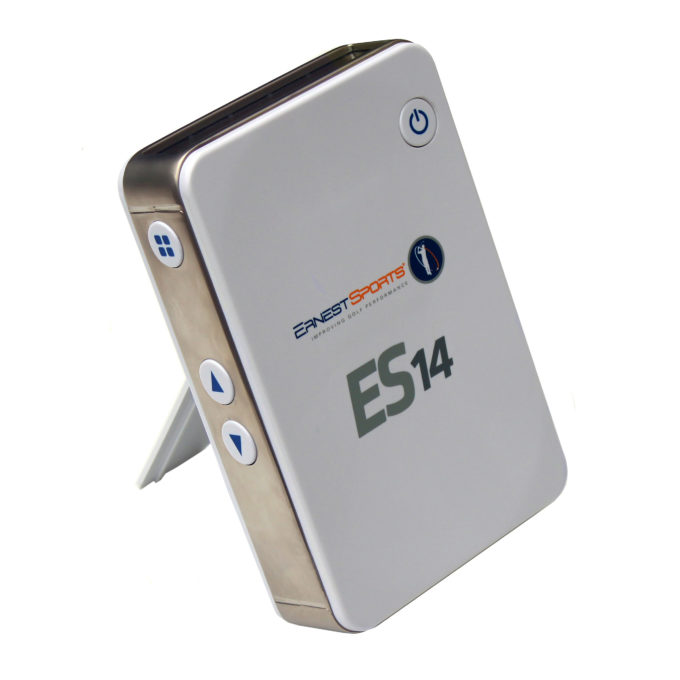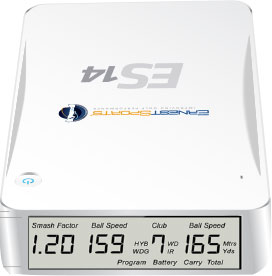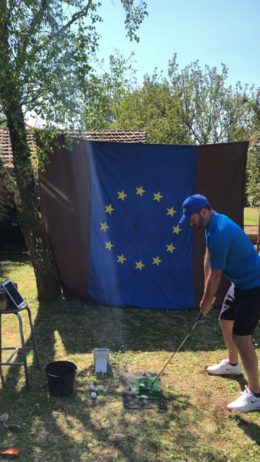Posted on May 24, 2020 in Equipment.
ES14 golf radar, the ultimate companion in containment but not only…
Confined test of ES 14, Ernest Sport's golf radar, by our tester Jean-François Ball, consultant for swing-feminin.com
Victim, like the whole golf community, of a restrictive order forbidding me to approach a course during these last two months of Covid-19 confinement, I still consider myself a little privileged. Indeed, I have a garden and above all I was lucky to receive a Sylosports package containing the holy grail of any confined golfer: a golf radar. I was therefore able to take advantage of this period to test Ernest Sports' golf radar, the ES 14, an educational tool:
For quite some time, during professional tournaments, we have seen small orange boxes blooming behind the players, at the practice. Become an almost indispensable tool in support of their coach, the Trackman not to name it helps and improves the level of play of the cadors of the white ball…. So why not that of amateurs.
The one and only obstacle is the price. With prices starting at over € 15000, we quickly understand that most golfers cannot afford it ...
But miraculously, in recent years, other companies like Flightscope or Ernest Sports have been offering more affordable products. In this category, Ernest Sports offers an extremely competitive product: the Radar ES14.
At this price we have what:
For around 600 € you can buy a very high-tech tool that uses the same Doppler technology as the market leader. This price is not due to low-cost manufacturing. It is made in the USA. To reach this price, the ES14 preferred to focus only on 6 criteria where its competitors can analyze more than a dozen.
- The total distance and the flight distance (carry) expressed in meters or yards
- Bale speed expressed in miles per hour (mph) or km / h
- Club head speed expressed in miles per hour (mph) or km / h
- The smash factor (ball speed / club speed ratio)
- The spin rate (or back spin rate) expressed in rotation per minute
- The launch angle of the ball expressed in degrees from the ground
To this list must be added another information provided by the ES14 is the management. But it turns out not to be reliable. It is not put forward on the brochure or the packaging of the product.
The ES14 is not a golf simulator but an option allows you to perform a small challenge with the Skill challenge option. The idea is to score points by achieving the distances proposed by the application ...
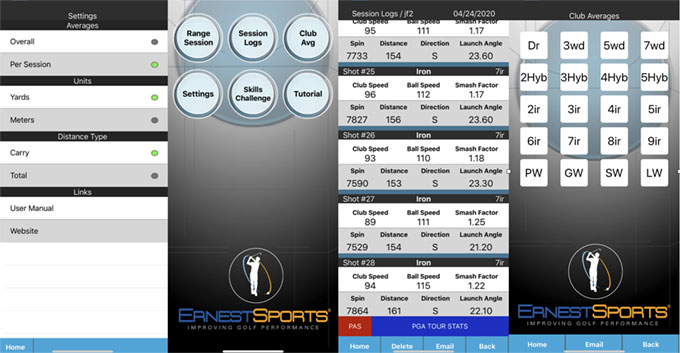 Getting started:
Getting started:
Getting started with the Radar ES14 is very simple. Although it doesn't fit in your pocket, you can take it anywhere. Measuring 20,5cmx13,5 × 5 and weighing barely 1kg, it works with a 9v battery giving it an autonomy of 17 hours. An optional outlet allows it to be connected to the mains.
For a better use it offers the possibility of adjusting criteria like the altitude but especially the lofts (opening of club) to be even more realistic. Because lofts can vary from one brand to another and even from one range to another.
For example, the loft of a 7 Titleist AP2 iron is 34 ° while a 7 Callaway Apex 19 iron is 30,5 °.
Once this little work is done, download the ES14 app to enjoy it on your smartphone or tablet. If there is a downside to the tool, this is where you will find it. The ergonomics and settings are a bit disappointing. We note here that the product is initially made for the American market. It is not possible to have club speed in miles and distance in m. It is miles and yards or Km / h and m. Nice, the export function in Excel table but again whatever the specificities chosen the results will be inexorably expressed in miles and yards. The view function in practice mode is useless, the radar really does not take into account the direction. After 500 balls typed and analyzed by the radar all were supposedly straight. In vain did I do bland balls, draw, push hooks… nothing to do the radar made lines still lines.
Other criteria are also to be tried. You can for example compare your data with that of the LPGA or PGA tour. If the club speed criteria are intimately linked to physical capacities, this is not the case for the smash factor or the launch angle (linked to the quality of the ball striking). Getting closer to the value of the pros in these sectors will save you a lot of distance and precision.
ES 14 test:
Little surprise, the product arises not 1 or 2 m behind the ball but rather within socket range. This can be a little scary for some players who are victims of this horrible disease.
The idea of sending a ball at 200 km / h in a box at 600 € can be a little freaking out. For the anxious, the miracle solution is to add a piece of foam in front of the radar or simply cover it with a bucket or, as I was able to test, with an old plastic potting pot. This does not interfere with the analysis, the Doppler passing without problem through. Be careful, however, to avoid denser materials such as wood or steel.
Note: the ESB1 model available since April 2020, is behind as its illustrious competitor.
On the way, I turn on the radar, I activate my phone's bluetooth and easily hear the ES14. I launch the application. A quick tour in Setting to finalize the settings. Yard or meter, Carry or total and in averages you can choose to compile all your results (overall) or to do it by session (per session).
Per session seems more interesting to me because if you decide, for example, to work on the half-strokes you can then isolate the results and thus avoid distorting your statistics of average distance per club. In addition, if there are several of you using the device, your data must be personal and not affected by the scores of one of your relatives…. With this choice you can be several to use the radar and thus have your own scores.
Then go to range Session. Create a session or resume one already started.
"Be careful, as before going on the course, it is better to do a small warm-up session to start the swing and thus use the radar in full possession of his gesture"
Select the chosen club on the radar and off you go.
I advise you to display the pga stats (take LPGA if you are a woman and PGA for men) to see how you compare to a perfect shot.
After a salvo of a hundred balls, the result is amazing, I find my distances and get very interesting additional information like club speed, ball, smash factor, spin and launch angle. It is very very close to the results obtained with the Trackman. Admittedly, I did not put the two products one beside the other but I have some data concerning me on mytrackman.com allowing me to compare.
No difference whether for irons or woods. The data remains very consistent.
The whole bag can pass through it (except the putter!). The Club Averages function then allows you to access its average distances and thus get to know each other better and make fewer club errors on the course. But it goes much further.
Take for example my Iron 7 stats by comparing them with that of the Pga tour:
Club speed 92 (mph) PGA average: 90
Smash factor: 1,23 PGA average: 1,33
Ball speed 112 (mph) PGA average: 120
Launch angle: 21,8 average PGA: 16,3
Spin: 7672 PGA average: 7097
Carry: 143m average PGA: 156m
To be fully comparable, the average PGA should be carried out with a loft equivalent to mine. But this is not the case, their clubs being more closed. All the same, at a glance it is clear that I am not optimizing my good club speed enough, my work must therefore focus on striking the ball, seeking to work on the smash factor and the launch angle. So take the ball more downhill and better compress it. This is the primary interest of a radar, to dissect the swing and work compartment by compartment. Primordial for a Pro but extremely useful for an amateur.
verdict:
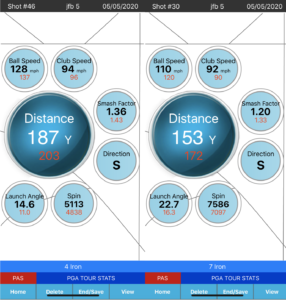 The Radar ES14 instantly gives you the mapping of your swing. It becomes easy to observe the progress made by comparing the different sessions over time. Physical and technical work is directly interpreted by the machine. Without taking itself for a clubmaker, the radar will also be very useful for testing new clubs, new shafts ...
The Radar ES14 instantly gives you the mapping of your swing. It becomes easy to observe the progress made by comparing the different sessions over time. Physical and technical work is directly interpreted by the machine. Without taking itself for a clubmaker, the radar will also be very useful for testing new clubs, new shafts ...
Ernest Sports has achieved the feat of providing, for a reasonable price, a product offering great analytical qualities that are largely sufficient for more than 98% of golfers. The ES14 is an entry-level radar but certainly not a low-end radar… Fun and fantastic I will no doubt have a hard time sending it back to Sylosports after this testing period….
News PRO/SLX from FOOTJOY
OGIO: trendy golf covers and bags
Qi from TaylorMade Golf, the new series of irons for performance






